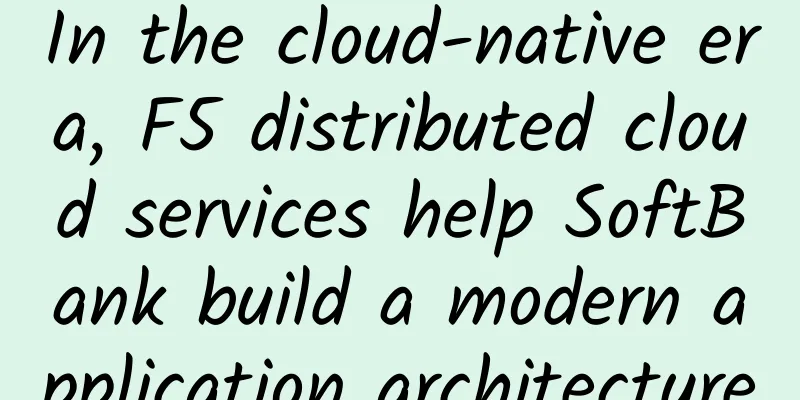In the cloud-native era, F5 distributed cloud services help SoftBank build a modern application architecture

|
Today, applications are in a stage of explosive growth, and applications that are critical to customers' digital transformation are also evolving and becoming more and more complex. However, the complexity of applications is not only in the applications themselves, but also extends to the infrastructure, from being deployed in only one data center in the past to the public cloud and hybrid cloud architecture. F5's "2022 Application Strategy Status Report" pointed out that 88% of enterprises are running traditional and modern application architectures at the same time, and 70% of enterprises have deployed multiple cloud environments, which brings huge challenges to enterprises in managing IT infrastructure. Founded in Japan, SoftBank Corporation focuses on providing telecommunications services and combining these services with advanced technologies to develop and operate new businesses in Japan and around the world. In Japan alone, SoftBank has more than 56 million mobile and broadband subscribers. As the business grows, SoftBank's enterprise information technology department found that the company needed to solve the problem of low resource utilization of private virtualized infrastructure and improve other inefficient businesses. However, this global company faced a dilemma - to meet security requirements, the company must adopt a local deployment method, and also support public cloud functions that may be introduced in the future. SoftBank hopes to introduce the high efficiency of cloud-native microservices and containers into its private data center, so it chose F5 distributed cloud services. Traditional IT infrastructure faces huge challenges SoftBank's corporate information technology department manages a massive IT infrastructure consisting of more than 800 systems, 20,000 servers, and 20,000 switches, with the number of servers increasing by several hundred per month. In the past, the company built its infrastructure based on virtual machines and single systems, which was well suited to the size of its workloads at the time. However, over time, the size and complexity of workloads changed dramatically. From a resource design perspective, the company configured resources with full consideration of busy hour requirements, but these resources could not be effectively utilized when idle, resulting in low overall utilization, with at least 1,500 servers with a maximum CPU utilization of only 10% and memory utilization below 50%. This significantly increased costs and led to other business inefficiencies due to the inability to manage the entire infrastructure. SoftBank's IT infrastructure department believes that with container virtualization technology, the company can adopt a microservices-based architecture, which can significantly improve resource utilization and flexibility, thereby handling more workloads at a lower cost. However, the company must integrate these cloud-native innovations into its current private environment. This means that it is necessary for the company to reduce the number of virtual machines by migrating workloads to containers and eventually replace them gradually. Another challenge the company faces is that the increase in the number of new internal systems forces the application department to spend a lot of time on system implementation. Given that SoftBank provides services to various industries such as technology, mobile, Internet, energy, and commerce, the company frequently adds new internal systems. The IT infrastructure department believes that the automation brought by cloud-native microservices can simplify the above development work and thus meet this challenge. In addition, SoftBank hopes to reduce the overall IT load so that employees can focus on their core business. By managing the infrastructure and updating or upgrading the platform through F5 distributed cloud services, the company expects to improve IT operational efficiency. Choose F5 distributed cloud service based on five features SoftBank examined three solutions from a technical perspective, namely F5 Distributed Cloud Service and two other solutions from well-known infrastructure vendors, in order to meet this IT infrastructure challenge and successfully conduct business. In 2020, after commercial screening, F5 Distributed Cloud App Stack and F5 Distributed Cloud Mesh were selected. This means that Distributed Cloud Service has been given the mission of "cloud native" and is responsible for protecting the private environment of IT infrastructure of SoftBank, one of the most influential companies in the world. SoftBank's IT Infrastructure Division expects that the use of a distributed cloud application stack solution will improve resource utilization and overall efficiency of its private infrastructure. SoftBank plans to achieve low latency and high security at the application and network layers within and between clusters by deploying a distributed cloud grid. F5's distributed cloud application stack platform was selected as the best solution for several reasons: the platform is based on lightweight microservices containers with integrated networking and security to protect containers and workloads; it separates tenants and namespaces through multi-tenant policies, and also provides role-based access control for tenants; it achieves a balance between enterprise security compliance and the agility required by business partners through policy-based automation; it has comprehensive centralized monitoring and management capabilities covering network, security, and applications; it has policies across applications and networks, and the ability to visually present and enforce these policies at network layers 3-7. From construction to operation, distributed cloud services bring significant efficiency gains Distributed Cloud Grid provides distributed application network and security services, which together with the distributed cloud application stack form part of the solution, and the integration capabilities of these technologies drove SoftBank to choose Distributed Cloud Services. Distributed Cloud Services stood out as the best solution from many alternatives mainly because of three advantages: Distributed Cloud Services fully supports namespace isolation of networks, microservices and applications, showing an advantage over competitors. Another advantage over other solutions is that it can centrally manage websites through a single user interface. In addition, it provides better functions, can be used for resource provisioning with almost zero touch, and is easy to manage and perform software upgrades. Other vendors' solutions require a separate software stack to run everywhere and support network splicing and other 4-7 layer services, regardless of infrastructure requirements, and these solutions cannot provide SaaS-based operations for applications and containers. Compared with any of them, F5's distributed cloud service has richer network functions, including easy extension of external network connections, and does not require integration with third-party software; therefore, the distributed cloud service shows extremely high efficiency from construction to operation. In general, F5's distributed cloud services bring two benefits to SoftBank. 1. Integrate with CI/CD tools to improve development efficiency Distributed cloud services work in conjunction with SoftBank's CI/CD (continuous integration/continuous delivery) process, so developers don't have to wait for application deployment to complete, reducing their workload. In addition, with managed Kubernetes, application development departments can automate the deployment of original applications and microservices. 2. Introducing Infrastructure as Code for Network Configuration The distributed cloud application stack is fully integrated with the distributed cloud grid, so every time there is a new requirement, the application development department can introduce infrastructure as code type network configuration into the private cloud, and automatically apply security measures at layers 3-7 without having to request network, security and policy from the IT infrastructure department separately. Looking to the future: containerization becomes the key word Containers are becoming a new interface for enterprises to use the cloud, bringing a new round of changes to the computing infrastructure and application architecture of enterprises. SoftBank has already planned this infrastructure change in its investment forecast for 2022-2025, and plans to increase investment in new container technologies and reduce virtual machine spending. According to the forecast, by 2025, the share of containers in enterprise IT infrastructure will increase from zero to 60%. Figure 1: The company’s compute resource forecast predicts that containers will outpace virtual machines by 2025. Using these new container technologies, the company plans to launch two major new applications to help increase sales and streamline transactions in physical stores and online, and distributed cloud services will play a key role in the success of both applications. Finally, despite the need to meet extremely high security requirements, the company still hopes to take advantage of the public cloud in the future for specific applications such as disaster recovery. |
<<: An article to introduce you to network protocols
>>: Architecture design of MQTT messaging platform for 10 million-level Internet of Vehicles
Recommend
Simple analysis of the three important requirements for remote network connections
The continuous emergence and upgrading of online ...
V.PS 10% off, US CN2 GIA/Hong Kong CMI/Japan IIJ & Softbank/Australia & UK AS9929 etc. available
V.PS is a cloud server site under xTOM, providing...
With 30,000 layoffs, what have American operators experienced?
According to public data, the scale of layoffs at...
Huawei's ecosystem is expected to prosper exponentially in response to demand
【51CTO.com original article】 As we all know, in t...
EtherNetservers special VPS starting from $14.95 per year - 1GB/40G SSD/1TB@10Gbps/Los Angeles & Miami & New Jersey data centers
EtherNetservers is a foreign hosting company esta...
The scale of data is growing explosively. Practical sharing of data-based operations of cloud-native data warehouses
At the recent 2021 Alibaba Cloud Financial Data I...
Fiber Optic Cable Types and Installation Tips
Expanding the presence of fiber optics has become...
China Minsheng Bank and Huawei reach strategic cooperation to build a digital smart bank with technology and finance
[Beijing, China, February 8, 2018] On February 8,...
"Rehabilitate" the Ethernet all-optical network! China Construction Association publishes the first standardization document for smart park construction
"Smart Park" is not a new concept. In t...
High-quality networks build differentiated competitiveness for operators and enable business success
[Shenzhen, China, July 30, 2020] Today, Huawei he...
Five reasons to upgrade your Wi-Fi router
Wi-Fi dramatically impacts everything from the se...
Five minutes to help you understand the difference between Http and Https protocols?
In the Internet world, HTTP and HTTPS are the two...
CloudCone 6th Anniversary Promotion Starting from $21.21/year, 1GB/30G SSD/1TB/Los Angeles Data Center
CloudCone started its 6th anniversary promotion i...
The three major operators’ annual data for 2021 were released. How is their performance?
In a blink of an eye, the Spring Festival holiday...
Telecommunications industry trends in 2017: SDN/NFV matures and wireless technologies become more unified
As the old saying goes, "It's hard to pr...









